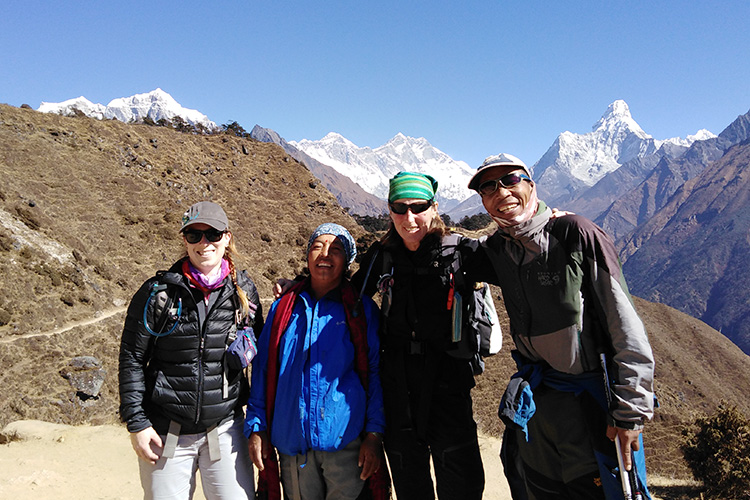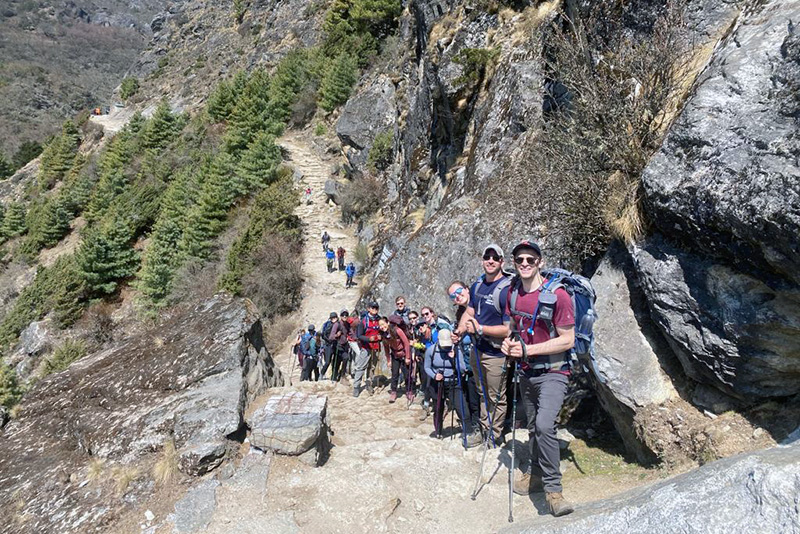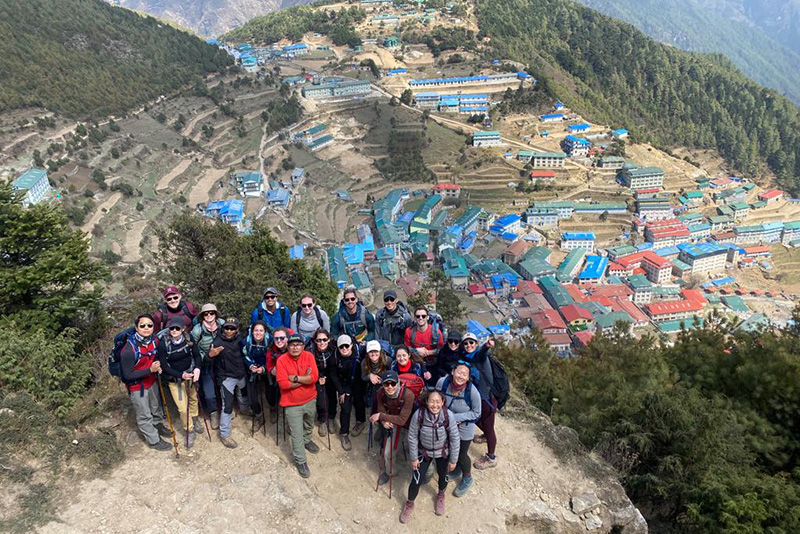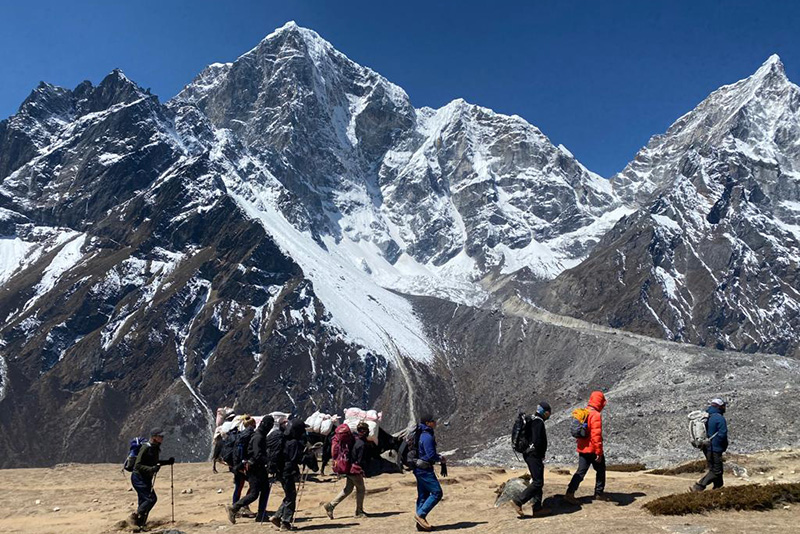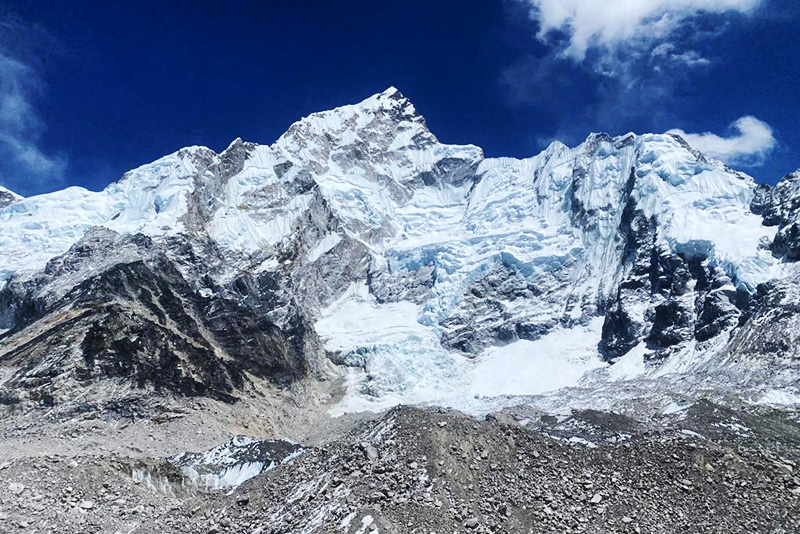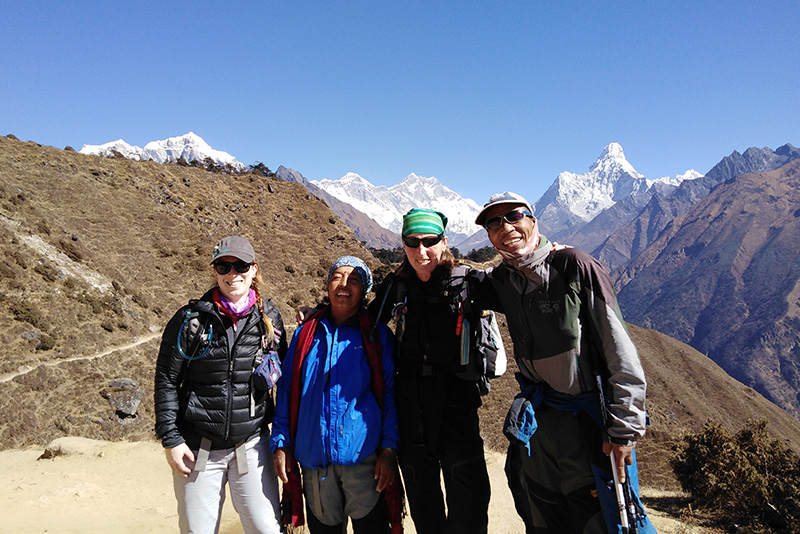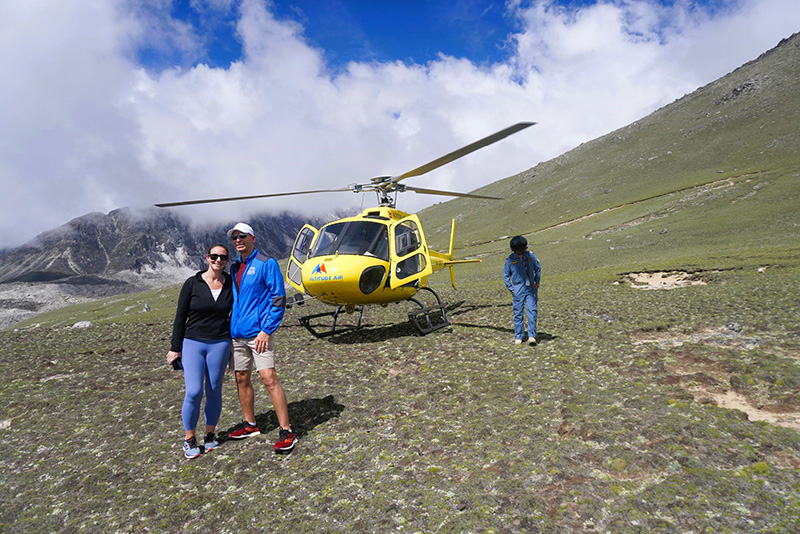Everest Base Camp Trekking options
Some of the best options for Everest base camp trek are here.
9 days Everest Base Camp Trek with Helicopter Return Itinerary
Day 1: Fly to Lukla and trek to Phakding (2,652m/8699ft), 4-5 hours.
Day 2: Trek to Namche Bazaar (3,440m/11,283ft), 5-6 hours.
Day 3: Acclimatization day at Namche Bazaar and hike to Everest View Hotel (3,9880m), 4 hours.
Day 4: Trek to Tengboche (38,60m/12,660ft), 5-6 hours.
Day 5: Trek to Dingboche (4410m/14464ft), 4-5 hours.
Day 6: Acclimatization day ad Dingboche.
Day 7: Trek to Lobuche (4,910m/16,105ft), 5-6 hours.
Day 8: Trek to Everest Base Camp (5,364m/17,594ft) and back to Gorekshep (5,181m/16,994ft), 8 hours.
Day 9: Hike to Kalapattar (5545m/18188ft) – Gorekshep – Kathmandu by Helicopter.
10 days Everest Base Camp Itinerary
Day 1: Scenic flight to Lukla and trek to Phakding (2,610m), 4-5 hours.
Day 2: Trek from Phakding to Namche Bazaar (3,440m), 5-6 hours.
Day 3: Acclimatization day at Namche Bazaar.
Day 4: Trek from Namche to Pangboche (3,930), 5-6 hours.
Day 5: Trek from Pangboche to Thukla (4,620m), 5-6 hours.
Day 6: Trek from Thukla to Everest Base Camp (5,170m) and back to Gora Shep (5,180m), 6-7 hours.
Day 7: Hike up to Kalapathar (5,550m) & trek to Pheriche (4,280m), 6-7 hours.
Day 8: Trek from Pheriche to Namche Bazaar (3,440m), 6-7 hours.
Day 9: Trek from Namche Bazaar to Lukla (2,860m), 6-7 hours.
Day 10: Fly from Lukla to Kathmandu (1,350m).
11 days Everest Base Camp Itinerary
Day 1: Fly from Kathmandu to Lukla (2850m) 40 minutes & trek to Phakding (2,650m), 4-5 hours.
Day 2: Trek from Phakding to Namche Bazaar (3,440m), 5-6 hours.
Day 3: Acclimatization at Namche Bazaar Hike to Everest View Hotel; Duration 34-5 hours.
Day 4: Trek from Namche Bazaar to Tengboche (3,860m), 5-6 hours.
Day 5: Trek from Tengboche to Dingboche (4,360m), 4-5 hours.
Day 6: Trek from Dingboche to Lobuche (4,930m), 5-6 hours.
Day 7: Trek from Lobuche to Gorakshep (5160m) & to Everest Base Camp (5360m) – return to Gorakshep;, 7-8 hours.
Day 8: Hike to Kalapathar (5,550m) & return to Pheriche (4,280m), 6-7 hours.
Day 9: Trek from Pheriche to Namche Bazaar (3,540m), 5-6 hours.
Day 10: Trek from Namche Bazaar back to Lukla (2,860m), 6-7 hours.
Day 11: Fly to Kathmandu from Lukla and transfer to hotel.
12 days Everest Base Camp Itinerary
Day 1: Fly to Lukla and trek to Phakding (2610m).
Day 2: Phakding to Namche Bazaar (3445m).
Day 3: Acclimatization in Namche Bazaar (3445m).
Day 4: Namche Bazaar to Tengboche (3867m).
Day 5: Trek to Dingboche (4360m).
Day 6: Day 08: Acclimatization in Dingboche (4360m.)
Day 7: Day 09: Trek to Lobuche (4930m).
Day 8: Trek to Gorakshep, Hike to Everest base camp & back to Gorakshep.
Day 9: Trek to Kalapathar (5,643m) & back to Pheriche (4,371m).
Day 10: Trek to Namche Bazaar.
Day 11: Trek back to Lukla.
Day 12: Fly to Kathmandu from Lukla and transfer to hotel.
13 days Everest Base Camp Itinerary
Day 1: Fly to Lukla (2,804 m) and Trek to Phakding (2,610 m), 4-5 hours.
Day 2: Trek to Namche Bazaar (3,441 m), 5-6 hours.
Day 3: Acclimatization day at Namche Bazaar.
Day 4: Trek to Dole (3,680 m), 5-6 hours.
Day 5: Trek to Gokyo (4,790 m), 5-6 hours.
Day 6: Trek to Gokyo Ri (5,483 m) and Back to Gokyo via Trek to Thangnak (4,500 m), 6-7 hours.
Day 7: Cross Chola Pass (5,368m) and trek to Dzongla (4,830m), 6-9 hours.
Day 8: Trek to Lobuche (4,910 m ), 4-5 hours.
Day 9: Trek to Everest Base Camp (5,365 m) and then Back to Gorak Shep (5,180 m), 6-7 hours.
Day 10: Hike Up to Kala Patthar (5,555 m) and Trek Down to Pheriche (4,300m), 6-7 hours.
Day 11: Trek to Namche Bazaar (3,441 m), 6-7 hours.
Day 12: Trek to Lukla (2,804 m), 6-7 hours.
Day 13: Morning Flight from Lukla to Kathmandu.
15 days Everest Base Camp Itinerary
Day 1: Fly to Lukla (2,850m/9,350 ft) 40 minutes, Trek to Phakding ( 2650 m/8562 ft ), 4-5 hours.
Day 2: Trek from Phakding to Namche Bazaar (3,440m/11,285 ft), 5-6 hours.
Day 3: Rest day and Acclimatization at Namche Bazaar.
Day 4: Trek to Tengboche (3790m), 5-6 hours.
Day 5: Trek to Dingboche (4,410m), 3-4 hours.
Day 6: Day trip to Chhukung valley and back to Dingboche, 4-5 hours.
Day 7: Trek to Lobuche (4950m), 5-6 hours.
Day 8: Trek to Everest Base camp (5364m), back to Gorakshep (5,180m), 6-7 hours.
Day 9: Early morning to Kalapather then trek to Dzonglha (4830m), 6-7 hours.
Day 10: Cross the Chola pass (5420m) then trek down to Tagnag(4695m), 7-8 hours.
Day 11: Trek to Gokyo (4800m) then visit fifth lake back to Gokyo, 3-4 hours.
Day 12: Climb to Gokyo Ri (5360m) and trek down to Dole (4,200m), 5-6 hours.
Day 13: Trek down to Namche (3,440m), 5-6 hours.
Day 14: Namche Bazaar to Lukla (2,850m/9,350 ft) 6-7 hours.
Day 15: Fly from Lukla to Kathmandu.
17 days Classic Everest Base Camp Itinerary
Day 1: Fly to Lukla (2,850m/9,350 ft) 40 minutes, Trek to Phakding ( 2650 m/8562 ft ), 4 hours.
Day 2: Trek from Phakding to Namche Bazaar (3,440m/11,285 ft), 5-6 hours.
Day 3: Rest day at Namche Bazaar for acclimatization.
Day 4: Namche Bazaar to Thame (3750m/12,303ft), 5-6 hours.
Day 5: Thame to Lungden (4500m/14,764ft), 5-6 hours.
Day 6: Lungden to Gokyo Lake (4750m) through Renjola Pass (5446m/17867ft)), 7-8 hours.
Day 7: Rest day to Acclimatize at Gokyo.
Day 8: Gokyo to Thangnak (4,700m/15,400ft) )Duration: 4-5 hours.
Day 9: Thangnak to Dzongla (4,855m/15,930 ft) through Cho La Pass (5420m/17,783ft), 6-7 hours.
Day 10: Dzongla to Lobuche (4,910m/16,175ft), 3-4 hours.
Day 11: Lobuche to Everest Base Camp and back (5,364m/17,598ft)to Gorak shep (5,185m/17,010 ft) 6-8 hours.
Day 12: Climb to Kala Patthar(5,55 5m/18,208ft) and trek to Lobuche (4,910m/16,175ft (4,250m/13,945ft) 5 hours.
Day 13: Lobuche to Chhukung (4730m/15580 ft) Via Kongma La (5535m/18159ft), 7-8 hours.
Day 14: Chhukung to Tengboche (3,855m/12,850ft), 4-5 hours.
Day 15: Tengboche to Namche Bazaar (3,440m/11,285 ft), 4-5 hours.
Day 16: Namche Bazaar to Lukla 2,850m/9,350 ft, 6-7 hours.
Day 17: Fly back to Kathmandu.
18 days Classic Everest Base Camp Itinerary
Day 1: Drive to Jiri & trek to Shivalaya (1,800m), 7-9 hours.
Day 2: Trek from Shivalaya to Bhandar (2,190m), 5-6 hours.
Day 3: Trek from Bhandar to Sete (2,575m), 6-7 hours.
Day 4: Trek from Sete to Junbesi (2,700m), 6-7 hours.
Day 5: Trek from Junbesi to Trakshindu (2,930m), 5-6 hours.
Day 6: Trek from Trakshindu to Paiya (2,730m), 5-6 hours.
Day 7: Trek from Puiyan to Phakding (2,600m), 5-6 hours.
Day 8: Trek from Phakding to Namche Bazaar (3,445m), 5-6 hours.
Day 9: Acclimatization at Namche Bazaar (3,440m)
Day 10: Namche Bazaar to Tengboche (3,860m), 5-6 hours.
Day 11: Trek from Tengboche to Dingboche (4,360m), 4-5 hours.
Day 12: Acclimatization at Dingboche & trek to Chhukung (4,360m), 4-5 hours.
Day 13: Trek from Dingboche to Lobuche (4,930m), 5-6hours.
Day 14: Trek from Lobuche to Gorakshep (5160m) & Everest Base Camp (5360m) – return to Gorakshep:, 6-7 hours.
Day 15: Hike to Kalapathar (5550m) & trek to Pangboche (3,985m), 7-8 hours.
Day 16: Trek from Pangboche to Namche Bazaar (3,440m), 5-6 hours.
Day 17: Trek from Namche to Lukla (2,860m), 6-7 hours.
Day 18: Fly from Lukla to Kathmandu.
Training for Everest Base Camp Trek Packing List
Making sure you have the right clothes, gear, and supplies for your Everest Base Camp trek will go a long way toward making sure you have a great time. As you pack for Everest Base Camp, keep in mind that your gear will be split into two bags: your daypack, which you will carry with you every day, and your duffle bag, which porters will carry between tea houses. You can leave any extra bags at the hotel before you start your hike.
This list has everything you need to bring to Everest Base Camp. It tells you what layers to bring to stay warm when the weather changes in the Himalayas, what gear you'll need to make your trek easy and comfortable, and what supplies you'll need to have the best time possible.
Clothing
Moisture-wicking long-sleeve t-shirts (2)
Moisture-wicking short-sleeve t-shirt (1)
Heavy fleece or down jacket
Gortex or waterproof jacket with hood
Windbreaker
Rain poncho
Fleece pants
Trekking pants (2)
Hiking shorts (1)
Waterproof pants
Hiking socks (10)
Warm thermal socks (1)
Long underwear (2)
Underwear (10)
Hiking boots with ankle support
Camp shoes or tennis shoes
Light inner gloves/glove liners
Insulated wool or down mittens/gloves
Sunglasses
Broad-brimmed hat
Neck gaiter or bandana (for sun protection)
Wool hat or balaclava (should cover ears)
Gaiters (needed Dec-Feb)
Sweatshirt (optional)
Sock liners (optional)
Trekking Gear & Supplies
40L Daypack for carrying what you need on the trail
Waterproof cover for daypack
Water bottles or hydration bladder
Sleeping bag rated to -18°C/ 0°F
Trekking poles
Headlamp with extra batteries
Lightweight water filter or iodine water tablets (personal preference)
Hand warmers
Travel pillow or pillowcase
Sleeping bag stuff sack
Drybags in several sizes
Stuff sacks for dirty clothes/shoes
Camera with extra batteries and memory cards
Small lock(s) for duffle bag and daypack
Sleeping bag liner (optional)
Quick-drying trekking towel (optional)
Toiletries
Sunscreen
Lip balm with sunscreen
Toilet Paper
Moleskin, medical tape, and/or duct tape for treating/preventing blisters
Advil or Ibuprofen
Diamox (for altitude sickness)
Personal prescriptions
Antibiotics (Cipro for travelers’ diarrhea)
Anti-chafe balm (e.g. Body Glide, to prevent chafing)
Diaper rash cream (Can treat rashes or chaffing)
Soap
Deodorant
Toothbrush/toothpaste
Razor (as needed)
Shampoo
Wet wipes
Hand sanitizer
Feminine hygiene products (as needed)
Face lotion
Hairbrush
Hair ties
Earplugs (for sleeping)
